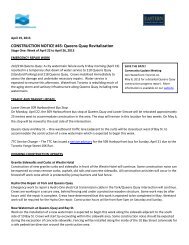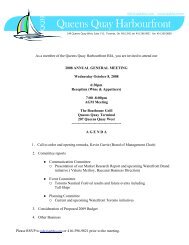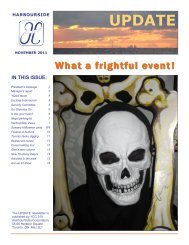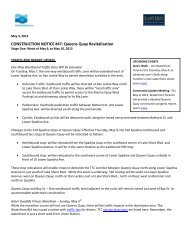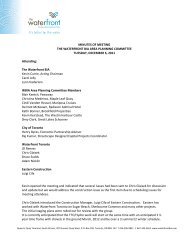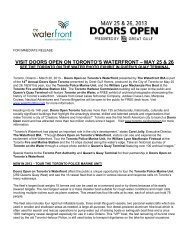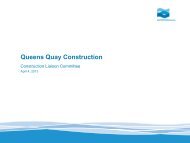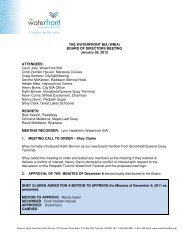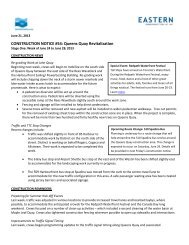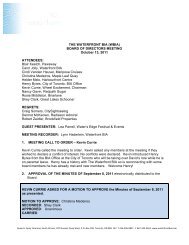CLC MEETING MINUTES #8 - Waterfront BIA
CLC MEETING MINUTES #8 - Waterfront BIA
CLC MEETING MINUTES #8 - Waterfront BIA
- No tags were found...
Create successful ePaper yourself
Turn your PDF publications into a flip-book with our unique Google optimized e-Paper software.
TORONTO PORT AUTHORITY<br />
AND<br />
BILLY BISHOP TORONTO CITY AIRPORT<br />
COMMUNITY LIAISON COMMITTEE<br />
<strong>MEETING</strong> <strong>#8</strong><br />
<strong>MEETING</strong> <strong>MINUTES</strong><br />
Wednesday November 21, 2012<br />
Harbourfront Community Centre<br />
Toronto, Ontario<br />
Minutes prepared by:
These meeting minutes were prepared by Lura Consulting. Lura is providing neutral third-party<br />
consultation services for the Toronto Port Authority Community Liaison Committee (<strong>CLC</strong>). These minutes<br />
are not intended to provide verbatim accounts of committee discussions. Rather, they summarize and<br />
document the key points made during the discussions, as well as the outcomes and actions arising from<br />
the committee meetings. If you have any questions or comments regarding the Meeting Minutes, please<br />
contact either:
Summary of Action Items from Meeting <strong>#8</strong><br />
Action<br />
Item #<br />
M<strong>#8</strong>-A1.<br />
M<strong>#8</strong>-A2.<br />
M<strong>#8</strong>-A3.<br />
Action Item Task<br />
Finalize TPA <strong>CLC</strong> Meeting #7 Minutes and In-Camera Session Notes,<br />
and post to TPA website.<br />
Improve the TPA website links by adding a tab for “In the<br />
Community”, where committee meeting minutes and related<br />
materials can be found.<br />
Consolidate the three points of contact for complaints in one place<br />
on the TPA website (TPA general inquires, TPA noise complaint<br />
office, and Forum Partners inquiry system).<br />
Who is Responsible<br />
for Action Item<br />
Lura / TPA<br />
TPA<br />
TPA<br />
Appendices<br />
Appendix A1-1: Tunnel Construction Committee Update Presentation<br />
Appendix A1-2: Billy Bishop Toronto City Airport Economic Impact Study Presentation<br />
Appendix A1-3: Emergency Services at Billy Bishop Toronto City Airport Presentation<br />
Appendix A1-4: Canada Malting Site Development Construction Activity Update<br />
List of Attendees<br />
Name Organization (if any) Attendance<br />
COMMITTEE MEMBERS<br />
Glenn Gustafson Con. Pam McConnell’s Office Present<br />
Hal Beck York Quay Neighbourhood Association (YQNA) Present<br />
Jen Chan Con. Adam Vaughan’s Office Present<br />
Brad Cicero Porter Airlines Present<br />
Heino Molls Bathurst Quay Neighbourhood Association (BQNA) Present<br />
Yemi Ifegbuyi <strong>Waterfront</strong> Toronto Present<br />
Carol Jolly <strong>Waterfront</strong> Business Improvement Area (W<strong>BIA</strong>) Sent regrets<br />
Con. Adam Vaughan City of Toronto, Ward 20 Sent regrets<br />
Con. Pam McConnell City of Toronto, Ward 28 Sent regrets<br />
Tony Makepeace Bathurst Quay Neighbourhood Association (BQNA) Sent regrets<br />
Warren Lampitt Air Canada Sent regrets<br />
Michelle Noble <strong>Waterfront</strong> Toronto Sent regrets<br />
David Whitaker Tourism Toronto Sent regrets<br />
Richard Joy Toronto Board of Trade Absent<br />
GUEST SPEAKERS AND SUBJECT EXPERTS<br />
Chris Dunn City of Toronto Present<br />
Gregory Kitscha Forum Equity Partners Present<br />
TPA REPRESENTATIVES<br />
Gene Cabral Toronto Port Authority Present<br />
Sylvain Theriault Toronto Port Authority Present<br />
Pat Fagnano Toronto Port Authority Present<br />
Helen Oel Toronto Port Authority Present<br />
Ken Lundy Toronto Port Authority Present<br />
Antonella Tarantino Toronto Port Authority Present<br />
FACILITATION AND SECRETARIAT<br />
Jim Faught Lura Consulting Present<br />
Patricia Halajski Lura Consulting Present<br />
MEMBERS OF THE PUBLIC<br />
Natalie Pastuszak Build Toronto Present<br />
1
1. WELCOME AND INTRODUCTIONS<br />
Gene Cabral, Airport Director, Billy Bishop Toronto City Airport (BBTCA), welcomed members of the Billy<br />
Bishop Airport Community Liaison Committee (BBTCA - <strong>CLC</strong>) to the eighth committee meeting. Mr.<br />
Cabral noted that draft meeting minutes from Meeting #7 were distributed via email to committee<br />
members for review, with a 4 week timeframe to provide comments, and were revised and finalized by<br />
Lura Consulting. Mr. Cabral noted this approach will be utilized for all future meetings. Mr. Cabral also<br />
explained that all efforts will be made to ensure meeting agendas and materials are provided to<br />
committee members electronically ahead of each meeting.<br />
Mr. Cabral then introduced Pamela McDonald, the new Communications Director for Toronto Port<br />
Authority, and noted Ms. McDonald would be attending all future committee meetings.<br />
Mr. Cabral then briefly reviewed the agenda for the meeting.<br />
2. REVIEW OF PREVIOUS <strong>MEETING</strong> <strong>MINUTES</strong><br />
Jim Faught, Committee Facilitator, Lura Consulting, reviewed the previous meeting minutes, including:<br />
<br />
<br />
Updated Meeting #7 Minutes; and<br />
Updated Meeting #7 In-Camera Session Notes.<br />
Currently, minutes are posted to the TPA website under the tabs “airport”, then “our environment”,<br />
then “committee minutes”.<br />
<br />
The YQNA representative requested that links on the TPA website be improved to be more<br />
intuitive and user friendly. Noting that the request was made at the last committee meeting, yet<br />
nothing has been changed on the website. The committee meeting minutes should be located<br />
under a new tab on the website sidebar such as “In the Community”.<br />
Mr. Faught explained a few minor comments were provided on the minutes by committee members<br />
prior to the meeting, and inquired whether members had any additional comments on the minutes or<br />
in-camera session notes. No additional comments were received and the minutes were approved.<br />
Actions:<br />
M<strong>#8</strong>-A1.<br />
M<strong>#8</strong>-A2.<br />
Finalize TPA <strong>CLC</strong> Meeting #7 Minutes and In-Camera Session Notes, and post to TPA<br />
website.<br />
Improve the TPA website links by adding a tab for “In the Community”, where<br />
committee meeting minutes and related materials can be found.<br />
3. TUNNEL CONSTRUCTION COMMITTEE UPDATE<br />
Greg Kitscha, Forum Equity Partners Inc., provided an update presentation on the construction process<br />
for the pedestrian tunnel to the Billy Bishop Toronto City Airport (BBTCA). Key points from Mr. Kitscha’s<br />
presentation included the following:<br />
2
The team is nearing completion of shaft construction on the mainland, and is almost ready to<br />
launch the tunnel boring machine to start the drift tunnels.<br />
The team is continuing shaft construction on the island, which is not as advanced as the<br />
mainland side.<br />
Preparing to launch the first Tunnel Boring Machine (TBM) in early December 2012.<br />
<br />
Moving forward, the construction of the drift tunnels will take place from November 2012 to<br />
February 2013.<br />
The construction of the pedestrian tunnel will take place from February 2013 to August 2013.<br />
<br />
The tunnel fit-out (e.g. escalators and moving sidewalks), and the construction of the buildings<br />
will take place from August 2013 to May 2014.<br />
Below is a summary of the comments and questions raised by committee members regarding the<br />
pedestrian tunnel construction update presentation:<br />
<br />
<br />
<br />
The BQNA representative inquired about the situation which occurred 9 years ago, when the<br />
bridge to the island was cancelled due to the federal government’s legislation prohibiting a<br />
“fixed link” to the island. The BQNA representative asked when the definition of “fixed link” was<br />
changed to allow a pedestrian tunnel. Ken Lundy, Toronto Port Authority, explained that the<br />
Toronto Port Authority Regulation was amended on September 30, 2011 to provide an<br />
exception for the pedestrian tunnel. The following link to Department of Justice provides details:<br />
http://laws-lois.justice.gc.ca/eng/regulations/SOR-2005-120/.<br />
The representative from Con. Vaughan’s office inquired about recent overnight construction<br />
happening on the island. Mr. Kitscha explained that overnight work was being performed over<br />
the past few weeks on the island. The work had to be scheduled during the overnight period<br />
because it would be very difficult preform the tasks when the airport was in operation. The<br />
excavated material is being kept on an infield site at the airport, so it can be used again for back<br />
fill. Mr. Cabral added that performing the work at night requires truck traffic across a runway<br />
which can only be completed when the airport is not operating at night. Mr. Kitscha explained<br />
that in order to reduce noise from backup beepers when the trucks reverse on site, a new<br />
routing was created that does not require trucks to reverse when picking up the excavated<br />
materials. Vehicles drive right in, get loaded up and go straight out, so no backing up is required.<br />
The YQNA representative noted that sporadic noise complaints may be due to varying<br />
environmental conditions, such as high wind, rain, or a calm day. These conditions can affect<br />
how noise if perceived and reported by residents. The YQNA representative explained that many<br />
local residents have simply given up on filing complaints because they feel nothing happens, and<br />
they are tired of receiving “boiler plate” responses. Mr. Kitscha explained that Forum Partners<br />
provides individual responses, and provides follow up calls when a noise compliant is submitted.<br />
o The YQNA representative noted that he logged 3 complaints about a month ago and<br />
received no response. However, the most recent inquiry was responded to. Mr. Kitscha<br />
explained that there is a procedure in place to ensure all complaints are addressed and<br />
responded to.<br />
o The YQNA representative was concerned that the phone hotline is a message centre, and<br />
is not answered by a live person. When a resident calls the line he or she expects a<br />
response within 2 hours or less, not 2 days later. Mr. Kitscha noted that the message<br />
centre is checked by a live person a few times per day.<br />
3
The BQNA representative noted that he logged a few complaints on the TPA website and<br />
received an email a few weeks later. Of the 4 inquiries submitted, only one received a response.<br />
Mr. Cabral explained that there is a distinction between the TPA noise complaint office website,<br />
the general TPA comment website, and the Forum Partners website. Mr. Kitscha added that<br />
anything related to construction should be forwarded to the Forum Partners website, whom<br />
have their own system for tracking and processing complaints. Forum Partners does not address<br />
complaints or questions about airport operations, such items should go to TPA. Mr. Cabral<br />
suggested that complaints can also be sent directly to him or Pamela McDonald.<br />
o The YQNA representative indicated that improving the TPA website, and consolidating all<br />
3 contact points into one webpage ‘button’ with potentially a drop down menu, may<br />
reduce the confusion about how to submit various comments or complaints.<br />
o Mr. Cabral explained that the TPA feedback form is separate from the online noise<br />
compliant form, but it may be worthwhile to streamline the two to make the process<br />
more user friendly. Ms. McDonald noted that she would look into streamlining the<br />
complaints and comment submission process.<br />
o The YQNA representative suggested that it may be consolidated under a “Contact Us”<br />
tab. He also noted that the construction website should be more responsive than TPA<br />
website.<br />
o Mr. Kitscha noted he would check with his team to see what happened to the<br />
complaints which did not receive responses.<br />
o Mr. Cabral explained that the TPA Noise Management Office has a process in place to<br />
ensure all inquiries receive a response within 5 days. TPA has dedicated staff to formally<br />
investigate and respond to noise complaints.<br />
The YQNA representative requested a frank discussion about whether the Noise Complaint Office<br />
is working. He noted that residents have been receiving boiler plate responses, which are not<br />
good enough. He also explained that in certain instances incorrect information is provided by the<br />
Office. For example, he observed a ferry that was sailing at 4 am, whereas the Office reported no<br />
ferry in their response. On another occasion, he observed jets flying through the BBTCA air space<br />
and was told by the Office no jets flew through the space at that date and time. Mr. Cabral spoke<br />
about the reported ferry incident, noting TPA staff reviewed the CCTV footage and no ferry was<br />
observed on the footage during the identified timeframe.<br />
o The YQNA representative noted that maybe the clock on the CCTV footage was not<br />
adjusted for daylight savings time.<br />
o The YQNA representative also noted an incident when he observed a helicopter land at<br />
BBTCA at 4:25 am and it wasn’t an ornge helicopter.<br />
o Mr. Cabral explained that the TPA staff at the Noise Complaints Office investigate and<br />
review the flight paths before sending a response to a noise compliant.<br />
o The YQNA representative was concerned that some planes are not registered on the TPA<br />
system.<br />
4
Actions:<br />
M<strong>#8</strong>-A3.<br />
Consolidate the three points of contact for complaints in one place on the TPA website<br />
(TPA general inquires, TPA noise complaint office, and Forum Partners inquiry system).<br />
4. BILLY BISHOP TORONTO CITY AIRPORT (BBTCA) ECONOMIC IMPACT STUDY<br />
Mr. Cabral and Ms. McDonald provided an overview presentation of the BBTCA Economic Impact Study<br />
conducted by InterVISTAS consulting group. Key points from the presentation included the following:<br />
<br />
In March 2012, InterVISTAS surveyed Greater Toronto Area businesses and organizations.<br />
The response rate for the survey was 74%.<br />
Those surveyed included BBTCA employers (13), offsite employers (12), and local hotels (7).<br />
<br />
<br />
<br />
<br />
<br />
<br />
<br />
<br />
Survey results indicate that ongoing operations at BBTCA generate a total annual economic<br />
impact of:<br />
o $1.9 billion in economic output;<br />
o Approximately 5,700 jobs representing 5,400 person years of employment;<br />
o $640 million in gross domestic product (GDP);<br />
o $290 million in wages, and<br />
o Overall tax revenue of approximately $57 million.<br />
Direct economic impacts include:<br />
o 1700 jobs associated with YTZ;<br />
o 1600 direct person years of employment;<br />
o $200 million in GDP;<br />
o $900 million in economic output; and<br />
o $74 million in wages.<br />
Indirect impacts include employment in non-airport industries that supply services to the<br />
industry. This includes approximately 2,670 jobs representing 2,540 person years of<br />
employment ($130 million in wages).<br />
Induced impacts include employment created due to expenditures by people employed directly<br />
or indirectly at the airport. This includes approximately 1,310 jobs representing 1,250 person<br />
years of employment ($76 million in wages).<br />
Total economic impacts include:<br />
o Approximately 5700 jobs, representing 5400 person years of employment;<br />
o $640 million in GDP;<br />
o $1.9 billion in economic output; and<br />
o $290 million in wages.<br />
BBTCA is a significant generator of taxation revenues, generating $57 million annually, of this<br />
$34.7 million in federal tax, $19.6 million in provincial tax, and $2.7 million in municipal tax.<br />
BBTCA also provides catalytic impacts, which are beneficial economic activities attributable to<br />
the presence of YTZ. Examples include tourism, foreign direct investment, and business<br />
relocations.<br />
Overall, it was concluded that BBTCA is a major economic engine for the Greater Toronto Area;<br />
plays a significant role in providing critical regional and continental transportation linkages; is an<br />
5
essential facilitator in the growth of trade and tourism for Toronto; and plays a key role in<br />
providing transportation access/links to other major business sectors.<br />
Below is a summary of the comments and questions raised by committee members regarding the<br />
economic impacts study:<br />
<br />
<br />
<br />
<br />
<br />
<br />
The YQNA representative requested clarification on the distinction between induced and indirect<br />
impacts. Mr. Cabral explained that indirect impacts include services such as hotel, taxi, and<br />
restaurants, whereas induced impacts are expenditures produced by island employees (e.g.<br />
airport staff spending money in the area).<br />
The representative from Con. Vaughan’s office inquired about the status of the PILTs dispute.<br />
Ms. McDonald explained that it was still under discussion with City Hall.<br />
The representative from Con. McConnell’s office asked how many people would use Pearson<br />
International Airport if BBTCA didn’t exist. He asked whether a comparison of that nature was<br />
done during the InterVISTAS study. Mr. Cabral explained that the current InterVISTAS study did<br />
not consider such a comparison, and wouldn’t be able to answer such a question. He explained<br />
that a recent transportation study examined where BBTCA users were coming from, indicating<br />
that 95% of users are located within the downtown core of Toronto. It is hard to say whether<br />
these users would go to Pearson Airport if BBTCA didn’t exist.<br />
o A committee representative noted that most passengers who fly through BBTCA would<br />
not be traveling or flying if they did not have this airport as an option. He noted there<br />
are a lot of competitive benefits to using BBTCA, such as lower fares when traveling<br />
through this airport. The committee representative also noted that the Windsor airport<br />
has seen an 80% increase in passengers now that Porter servers their route. Since 2006,<br />
Porter Airlines has added more destinations based on increased demand.<br />
o The BQNA representative noted that this community is very mistrustful of TPA and any<br />
studies performed by TPA consultants. He stated it was a reach to show the advantages<br />
of the airport, given that just as many people would use Pearson International Airport or<br />
other modes of transport.<br />
o A Committee representative explained that in 2006 the airline was operating and<br />
functioning at a modest level, and couldn’t viably operate from Pearson airport. Porter<br />
Airlines would not be able to compete against West Jet and Air Canada at Pearson<br />
airport. Porter needed the downtown airport location to survive. The committee<br />
representative also noted that many jobs are associated with BBTCA and commercial<br />
aircraft operations here, such as security and customs.<br />
The YQNA representative asked how many employees were working at BBTCA in 2006. Mr.<br />
Cabral replied that he didn’t have that data, adding that 25,000 passengers used the airport in<br />
2006.<br />
The YQNA representative asked whether the Economic Impact Study has it been peer reviewed.<br />
Ms. McDonald responded that the Toronto Board of Trade reviewed the study.<br />
The YQNA representative felt the economic impact of BBTCA was surprisingly small. Noting that<br />
as a cost engineer, 2 or 3 of his developments for sewers infrastructure would equal the GDP of<br />
this airport. He stated that the community is of the opinion that there is no net benefit provided<br />
by the airport, and wondered what would be the net benefit loss if Porter Airlines was running<br />
out of Pearson International Airport.<br />
6
o<br />
o<br />
o<br />
o<br />
A committee representative explained that Porter would simply not exist if it wasn’t for<br />
BBTCA. Porter has invested millions of dollars in the BBTCA facility, and cannot simply<br />
transfer its operations to Pearson Airport. Porter also specifically purchased aircraft that<br />
area designed to operate at BBTCA, and different aircraft would be required to operate<br />
at Pearson airport.<br />
The YQNA representative asked what would be different if Porter Airlines moved to<br />
Pearson International Airport. What would be the economic loss He suggested that the<br />
loss may simply be direct flights to Windsor. He suggested that although currently Porter<br />
is not competitive enough to move to Pearson, the community would like to know how<br />
much Porter needs to grow in order to move to Pearson.<br />
A committee representative noted that the mandate of this committee was not to<br />
advocate for moving Porter Airlines to Pearson airport, or closing BBTCA.<br />
The YQNA representative asked about the cost of the airport to the City of Toronto and<br />
to the community. He noted a full economic impact analysis would examine both the<br />
costs and not just the benefits of BBTCA.<br />
5. BBTCA AND EIREANN QUAY STRATEGIC TRANSPORTATION PLAN<br />
Chris Dunn, City of Toronto, provided a brief updated about the BBTCA and Eireann Quay Strategic<br />
Transportation Plan. Key points from the update included the following:<br />
<br />
The City of Toronto is working with the Toronto District School Board (TDSB) and Toronto Port<br />
Authority (TPA) on a long term transportation study of Eireann Quay.<br />
The study began in August 2012.<br />
A Community Liaison Committee meeting for the study was held on Tuesday November 6, 2012.<br />
Committee members had an opportunity to engage in 6 themed workshops aimed at identifying<br />
transportation planning solutions for further consideration, including medium and longer term<br />
solutions. All meeting materials and workshop summaries are available on the project website<br />
(www.toronto.ca/planning/tp_strategic_plan.htm).<br />
<br />
<br />
<br />
<br />
<br />
The committee members’ suggestions will be reviewed by the technical group in order to refine<br />
the proposed transportation solutions.<br />
A public meeting will be held on Wednesday December 12, 2012 to review the results and<br />
revisions to the transportation plan. It is anticipated that another public meeting will be held<br />
prior to report finalization. Public meeting notices will be sent to the TPA for distribution.<br />
The City is aware that there is congestion on Eireann Quay, and City staff are currently<br />
examining signal timing and equipment functioning on site.<br />
The City has also been asked to consider implementing a bike lane on Queens Quay along Little<br />
Norway Park. This request was made by Con. Adam Vaughan’s office.<br />
The City is on track to deliver the study final results in February or March 2013 as a report to<br />
Council.<br />
There were no questions for Mr. Dunn following his update.<br />
7
6. UPDATE ON LAKE FILL WITHIN MARINE EXCLUSION ZONE<br />
Ken Lundy, Toronto Port Authority, provided a brief update on the proposed Lake Fill that is to be<br />
implemented in the Marine Exclusion Zone. Key points made by Mr. Lundy during his update included<br />
the following:<br />
<br />
<br />
<br />
<br />
<br />
<br />
The Lake Fill project will encompass the inner harbour immediately east of the end of runway<br />
0826.<br />
The environmental assessment (EA) for the project is coming to an end.<br />
There has been some concern about the old tunnel running from Centre Island across to the<br />
John Street pumping station. This tunnel is below the lake bottom rock level and dates back to<br />
around 1906 or 1908. A finite loading analysis was performed to determine the impact of the<br />
lake fill project on this tunnel structure and the loading was found to be minimal.<br />
The final EA report should be available at the end of the month, and will be posted to the TPA<br />
website.<br />
A Terms of Reference (TOR) and Scope of Work have been developed for the project, which<br />
includes the mitigation measures identified as part of the EA. The contractor is currently<br />
reviewing the pricing of equipment needed on the marine side, and TPA hopes to review the<br />
contract the week of December 3, 2012.<br />
It is anticipated that in February 2013, the larger pieces of excavated material from the<br />
pedestrian tunnel construction will be used for the lake fill, since this material meets the size<br />
specifications.<br />
Below is a summary of the comments and questions raised by committee members regarding the lake<br />
fill update:<br />
<br />
<br />
<br />
<br />
The YQNA representative asked when the process for moving the excavated material by barge<br />
will take place. Mr. Lundy noted that it would occur from February to June 2013.<br />
The YQNA representative noted that in the summer residents will be opening their windows and<br />
noise is a concern. Mr. Lundy stated that the process is very quiet. The tug boat moves the<br />
material and it takes about 1.5 to 2 hours to complete one load.<br />
The YQNA representative inquired whether the noise impacts will be include in the final report.<br />
Mr. Lundy said that noise impacts have been identified and reported on, and will be at a low<br />
noise level.<br />
o The YQNA representative was worried that during sleeping hours even low noise is a<br />
concern.<br />
The YQNA representative stated that the lake fill project will create an underwater berm in the<br />
exclusion zone. Noting that there are about 40 incidents of vessels entering the exclusion zone<br />
per year. He asked what happens if a vessel enters the zone, and if there is an excavation plan in<br />
place. Mr. Lundy explained that there is a procedure for addressing a boat that enters or gets<br />
marooned in the exclusion zone. The NavCanada procedure involves closing the runway if it is a<br />
large vessel.<br />
o The YQNA representative was concerned about the process for a boat that gets beached<br />
in the area. He inquired whether this occurrence would close the airport. Mr. Lundy<br />
stated that the infill would stop a vessel from reaching the area closest to the airport,<br />
since the water in the area will be about 1 metre deep.<br />
8
The YQNA representative inquired about floating debris and the process for flushing it out of the<br />
exclusion zone. He asked whether the area was self-flushing. Mr. Lundy noted that the cap which<br />
will be placed over the fill is in the order of 1 metre below the surface, making the area selfflushing.<br />
No debris will get stuck in the exclusion zone.<br />
The BQNA representative discussed the public meeting which was recently held to update the<br />
community on the lake fill project. He noted that an oceanographer present at the meeting<br />
spoke passionately about his concerns with the material being used for the fill. The<br />
oceanographer noted that shale would harm marine life and kill the fish. Mr. Lundy explained<br />
that a thorough report was done on the material to be used for the lake fill. The TPA worked<br />
with Toronto Region Conservation Authority (TRCA) and the Ministry of Fisheries and Oceans to<br />
review the material to be used. In order to mitigate any possible negative impacts from the<br />
shale, a cap of 0.7 m will be placed on top of the fill. The cap will not deteriorate like the shale,<br />
and will be safe for fish.<br />
The BQNA representative stated that TPA committed to communicating with the Mississauga<br />
First Nations about this project. He explained that he contacted the First Nations and was told<br />
they were opposed to the lake fill project. Mr. Lundy stated that TPA has not received any<br />
communications from the First Nations community opposing the project.<br />
The YQNA representative inquired when the next public meeting regarding the lake fill project<br />
would take place. Mr. Lundy stated a meeting would occur once TPA is provided with<br />
information from the marine contractor regarding the construction procedure. The meeting is<br />
anticipated to take place in early 2013.<br />
7. EMERGENCY SERVICES AT BILLY BISHOP TORONTO CITY AIRPORT (BBTCA)<br />
Sylvain Theriault, Fire Chief, BBTCA, provided a presentation about the emergency services and<br />
procedures currently in place at BBTCA. Key points from the presentation included the following:<br />
<br />
<br />
<br />
<br />
<br />
BBTCA Fire Services has decided to focus on growing emergency services to match the growth of<br />
the airport.<br />
The TPA Board of Directors and Executives decided to exceed Canadian Aviation Regulations<br />
minimum requirements for BBTCA.<br />
Fire Services have increased from 2 firefighters and 1 auxiliary staff per shift, to 4 firefighters<br />
and 1 auxiliary staff per shift. As well as adding 1 cover off position, and a Fire Chief.<br />
In the past BBTCA Fire Services were limited in their capabilities:<br />
o Aircraft emergencies – BBTCA relied on Toronto Fire Service (TFS) and Marine Unit as<br />
back-up.<br />
o Medical emergencies – BBTCA was extremely limited and relied heavily on Toronto<br />
Emergency Medical Services (TEMS) as the primary responder.<br />
o BBTCA had no structural response – TFS was the primary response for such occurrences.<br />
Currently, BBTCA Fire Services capabilities have improved to include the following:<br />
o Aircraft emergencies – TFS and Marine Unit are back-up, with a more robust integrated<br />
response with BBTCA Fire Services.<br />
o Medical emergencies – BBTCA Fire Services is the primary responder, with TEMS as the<br />
back-up.<br />
9
o<br />
Structural response – TFS remains primary responders with BBTCA Fire Services<br />
integrated as local experts.<br />
Adjustments have been made to the Airport Emergency Response Plans to match the new<br />
capabilities.<br />
BBTCA Fire Services has increased response robustness through meetings and training with: TFS,<br />
TEMS, Toronto Police Services (TPS), HMCS York, and ornge.<br />
BBTCA Fire Services is implementing the following strategic objectives:<br />
o Create and teach a modified Aircraft Firefighting course to TFS.<br />
o Ensure a window of self-sufficiency of at least 45 minutes for structural firefighting and<br />
other responses.<br />
o Enhance emergency response robustness through:<br />
• Internal and joint emergency services training,<br />
• Acquisition of new vehicles and equipment,<br />
• Further strengthening working relationships with surrounding emergency<br />
services, and<br />
• Strengthening response protocols.<br />
Below is a summary of the comments and questions raised by committee members regarding the<br />
emergency services presentation:<br />
<br />
<br />
<br />
The BQNA representative was concerned that the runway was not long enough. Noting that in<br />
his understanding airports need an area at the end of the runway for planes if they overrun the<br />
runway. He was concerned that Porter planes are too big for the BBTCA runway. He inquired<br />
how BBTCA is able to meet safety requirements if the planes are too big and there is no room at<br />
the end of the runway for emergencies. Mr. Lundy explained that Transport Canada performs<br />
regular audits of the airport. BBTCA also has an additional 300 feet at each end of the runway to<br />
accommodate emergencies. The Q400 aircraft is specifically rated for BBTCA, and Transport<br />
Canada gives certification for that aircraft to be used by the airline operating out of this airport.<br />
The BQNA representative asked whether seats have to be removed from the planes in order to<br />
meet regulations. Mr. Lundy explained that runway length required by a plane is based on<br />
takeoff loads, and it part of the safety precautions used by the airport.<br />
o Mr. Theriault stated that BBTCA currently meets all regulations. As the Fire Chief he is<br />
responsible for emergency planning for all emergencies, and the airport is in<br />
compliance.<br />
o A committee representative noted that Porter planes have 70 seats whereas Air Canada<br />
operates with 74 seats. Porter Airlines service is about passenger comfort on board, and<br />
has nothing to do with cutting seats to meet safety requirements.<br />
o Pat Fagnano, Toronto Port Authority, added that before each takeoff BBTCA takes into<br />
consideration the length of the runway required to abort if the plane does not takeoff<br />
before reaching the available stop distance.<br />
The YQNA representative inquired how BBTCA coordinates all emergency services through the<br />
unified command structure. Who takes the lead for medical emergencies Mr. Theriault<br />
explained that BBTCA Fire Services takes the lead, and there is a specified process for how this is<br />
done. Previously BBTCA answered 19 medical emergency calls per year, now BBTCA has<br />
answered 52 calls since January 2012. These range from minor issues such as fainting or a cut, to<br />
10
more serious issues such as cardiac arrest. The BBTCA Fire Service response time on site is 3<br />
minutes to arrive and start providing medical assistance.<br />
The YQNA representative asked about the instance in which a fire or a disaster strikes a terminal<br />
building. Is there a risk to local mainland residents Mr. Theriault stated that the impact of the<br />
terminal catching on fire would be the same a residential building catching on fire. The bigger<br />
concern is if the airplane hanger caught fire, due to the fuel which is stored on site. In such a<br />
situation, the unified command would request an evacuation of the affected area or order local<br />
mainland residents to close their windows and doors.<br />
o The YQNA representative asked how fuel is being stored at BBTCA, and how would this<br />
be impacted by a fire. Mr. Theriault noted that fuel storage is currently on the<br />
southwest corner of the airport, and is far away from the runway to ensure safety.<br />
8. CANADA MALTING SITE CONSTRUCTION UPDATE<br />
Ken Lundy, Toronto Port Authority, provided a presentation on the construction taking place on the<br />
Canada Malting, along Eireann Quay. Key points from the presentation included the following:<br />
<br />
<br />
<br />
<br />
<br />
<br />
Current traffic management construction initiatives include:<br />
o Taxi Staging Area (manage 44 cabs);<br />
o Vehicle Parking (short-term and long-term parking); and<br />
o Street Traffic Management (left-turn lane and “no stopping” signage).<br />
The taxi staging area is under development on the vacant Canada Malting lands following Site<br />
Plan Approval. The construction Includes:<br />
o Underground services (water, storm sewers, and sanitary);<br />
o Small washroom service building for taxi drivers; and<br />
o Paving and traffic controls.<br />
The following items in and around the taxi staging area are completed:<br />
o Tree protection and seeding;<br />
o Water connection;<br />
o Sanitary manhole and piping;<br />
o Exploratory work for City connections;<br />
o Entrance to taxi staging area reconfiguration;<br />
o Storm sewer manholes and crossing; and<br />
o Paving work and pickup platform.<br />
Next steps for the taxi staging area include building the overhead canopy, washroom building<br />
(end of November 2012), and taxi operation repositioning (December 2012).<br />
Once the taxi staging area and short stay parking are implemented, traffic lane changes will be<br />
coordinated with the City.<br />
Vehicle parking will be developed on site, and will include short-term (17 spaces) and long-term<br />
(26 spaces) parking.<br />
The parking areas should be operational by the end of November 2012.<br />
Final landscaping will be delayed until the Spring.<br />
Below is a summary of the comments and questions raised by committee members regarding the<br />
Canada Malting Site Construction presentation:<br />
11
The representative from Con. Vaughan’s office inquired whether TPA will provide staff to circle<br />
around and direct people to the new parking spots, as people get used to the new layout. Mr.<br />
Lundy stated that a paid duty officer will be on site to direct traffic.<br />
The representative from Con. Vaughan’s office asked whether Toronto District School Board<br />
(TDSB) would be involved in the operation of the pick-up / drop-off area for the school and<br />
community centre. Mr. Lundy replied that TPA is currently in contact with TDSB and it is<br />
anticipated they will operate the school pick-up / drop-off area.<br />
Mr. Cabral noted that he has heard some concern from residents about the taxi staging area<br />
getting full. He explained that a full ferry requires up to 55 cabs, and the taxi staging area holds<br />
44 taxis.<br />
o Mr. Lundy added that a sign is contemplated to be posted at the top of Eireann Quay so<br />
taxi drivers will know whether the lot is full or spots are still available. This will help<br />
manage taxi traffic on Eireann Quay, and prevent cabs for driving down the street to<br />
look in the staging area.<br />
The BQNA representative stated that there are hundreds of children in area, due to the two local<br />
schools, day care centre and community centre. He stated that none of the traffic management<br />
and taxi management solutions will solves the danger to the children. Drivers continue to speed<br />
through the neighbourhood to get to the airport. His suggested solution is to either move the<br />
airport or move the community.<br />
9. BUSINESS ARISING<br />
Mr. Faught asked <strong>CLC</strong> members if they had any business arising that they would like to discuss, hearing<br />
none, Mr. Faught proceeded to adjourn the meeting.<br />
10. WRAP UP<br />
Mr. Faught thanked TPA employees for attending the meeting. The next BBTCA - <strong>CLC</strong> Meeting is<br />
scheduled for Tuesday February 19, 2013. A private “in camera” session was then held with <strong>CLC</strong><br />
members only.<br />
ADJOURN<br />
12
Appendix A1-1<br />
Tunnel Construction Committee Update Presentation
Appendix A1-2<br />
Billy Bishop Toronto City Airport Economic Impact Study Presentation<br />
BILLY BISHOP TORONTO<br />
CITY AIRPORT<br />
ECONOMIC IMPACT STUDY<br />
Presentation to the Community Liaison Committee<br />
Wednesday, November 21, 2012<br />
By: Gene Cabral and Pamela McDonald
Appendix A1-3<br />
Emergency Services at Billy Bishop Toronto City Airport Presentation
Appendix A1-4<br />
Canada Malting Site Development Construction Activity Update



